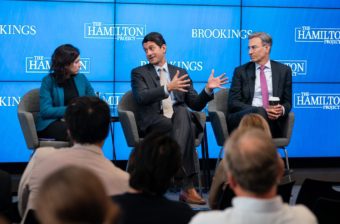The Problem
Two factors primarily account for relatively low amounts of retirement savings by low- and middle-class Americans. The first is that most employer-sponsored retirement savings plans—typically 401(k) plans or individual retirement accounts (IRAs—require employees to opt in, rather than opt out, and far too many never make that first step. The second is that tax incentives for saving are relatively weak at the low- and middle-class tax brackets.
The Proposal
A series of coordinated policy, tax, and regulatory measures would help to set working Americans on a sustainable path toward fiscal stability in retirement. Proposals include making 401(k) or IRA participation the default, instituting automatic escalation over time, guaranteeing account investment diversification and rollover flexibility, and shifting the government’s savings incentive from a tax-based one, which benefits higher-earning households, to a government matching one.
Abstract
Many middle- and low-income Americans retire without having accumulated sufficient savings to enjoy a comfortable retirement. Low retirement saving is not primarily due to a lack of eligibility for tax-favored retirement accounts, but rather to a lack of take-up. The low take-up, in turn, can be explained primarily by inertia and incentives. People do not enroll in a 401(k) or an individual retirement account (IRA) because such plans typically require specific actions to join and present a confusing array of investment and contribution choices. Under current rules, not making a decision usually means not enrolling. Furthermore, the financial incentive to enroll in an IRA or 401(k) plan is often weak or nonexistent because the value of contributing money, and thus excluding it from taxation, depends on a taxpayer’s tax bracket — and the majority of households face a 15 percent or lower marginal tax rate.
We offer proposals to address both impediments to saving. First, we would require every firm (with possible exceptions for the smallest businesses) to enroll its new workers automatically in at least one plan: a traditional defined benefit plan, a 401(k), or an IRA. Businesses also would be required to set various features of the plans in a “pro-saving” manner, although workers always would have the option to override those “pro-saving” defaults. Second, our proposal would replace current tax deductions for contributions to tax-preferred retirement accounts with a new program providing universal matching contributions from the government for household deposits to 401(k)s and IRAs. Unlike the current system under which low-income households enjoy much weaker immediate incentives to contribute than high-income households, all households making a qualified contribution to a 401(k) or IRA would receive the same 30 percent match from the government. We also propose other changes to the retirement system to promote lifetime annuities.




